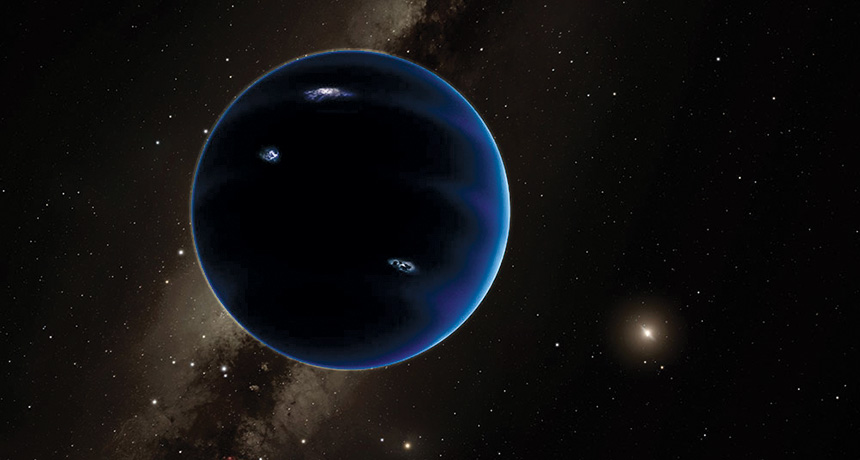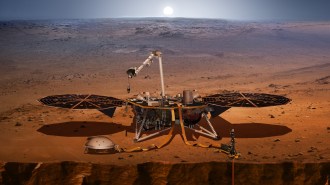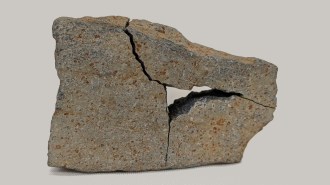New clues in search for Planet Nine
New location, brightness projections raise hopes of actually spotting distant world

SOLAR SYSTEM SEARCH Researchers are trying to pin down where to find a hypothetical ninth planet in the solar system (illustrated).
R. Hurt/IPAC, Caltech
- More than 2 years ago
More clues about where to search for a possible ninth planet lurking in the fringes of our solar system are emerging from the Kuiper belt, the icy debris field beyond Neptune. And new calculations suggest that the putative planet might be brighter — and a bit easier to find — than once thought.
Evidence for the existence of Planet Nine is scant, based on apparent alignments among the orbits of the six most distant denizens of the Kuiper belt (SN: 2/20/16, p. 6). Their oval orbits all point in roughly the same direction and lie in about the same plane, suggesting that a hidden planet, about five to 20 times as massive as Earth, has herded them onto similar trajectories.
Planetary scientists Mike Brown and Konstantin Batygin, both at Caltech, announced this evidence in January. Now they’ve used it to refine Planet Nine’s properties and narrow in on where it might be hiding. Their results appear in the June 20 Astrophysical Journal Letters.
Planet Nine’s average distance from the sun is most likely between 500 and 600 times as far as Earth’s, Brown and Batygin report. Its orbit is highly stretched and tipped by about 30 degrees relative to the rest of the solar system, taking it well above and below the orbits of the eight known worlds. And right now, it’s probably near its farthest point from the sun — possibly as far as 250 billion kilometers away — in a large patch of sky around the constellation Orion.
But the evidence depends on orbital oddities among just six frozen worlds. “The argument that a planet is there is not ironclad,” cautions Renu Malhotra, a planetary scientist at the University of Arizona in Tucson. “I think it’s worth studying. There’s enough there to not ignore this evidence,” she adds. “We just shouldn’t get depressed if the planet’s not there.”
Malhotra and colleagues have been looking for independent evidence for a ninth planet. And they think they’ve found another clue: The orbital periods of those six bodies are roughly synced to one another, her team reports in the same journal. For example, the most distant one, the dwarf planet Sedna, goes around the sun five times in about the same amount of time that its neighbor, 2010 GB174, completes eight orbits. Such synced orbits usually hint at some gravitational link among all the bodies involved. But these minuscule worlds are too tiny to affect one another, says Malhotra, suggesting there’s a more massive culprit.
A planet at least 10 times as massive as Earth and orbiting the sun once every 17,117 years would be in sync with four of these bodies, Malhotra and colleagues find. That puts Planet Nine, on average, about 100 billion kilometers from the sun, or roughly 665 times the distance between the sun and Earth.
The synced orbits are “very intriguing and very interesting,” says Scott Sheppard, a planetary scientist at the Carnegie Institution for Science in Washington, D.C. “But they need more of these objects to say if it’s statistically significant or not.” Sheppard and Chad Trujillo, of the Gemini Observatory in Hilo, Hawaii, also suggested, in 2014, that a ninth planet could explain the orbits of a dozen worlds (including the aforementioned six) in the Kuiper belt (SN: 11/29/14, p. 18).
“We want to discover more of these smaller [bodies], which are more numerous and can lead to the big one,” says Sheppard. He and Trujillo are hunting for remote Kuiper belt objects with telescopes in Chile and Hawaii. They’ve had some success, adding a few to the census of far-flung lumps of ice. And the orbits of these new discoveries show hints of being aligned with each other and the previously found dozen, he says. But more observations and analysis are needed to be sure. Sheppard and Trujillo have already been allotted several weeks on telescopes this fall, when the constellation Orion (the best guess at Planet Nine’s location) is visible. “We’ll be looking for more [distant] objects,” he says. “And possibly a large planet as well.”
If a slew of new objects helps astronomers zero in on Planet Nine’s location, there’s a chance that it could be directly seen. Its chilled atmosphere (colder than about ‒220° Celsius) might contain only hydrogen and helium gas, which are good at reflecting light, Jonathan Fortney, a planetary scientist at the University of California, Santa Cruz, and colleagues report in the June 20 Astrophysical Journal Letters.
“We expect the planet, if it’s there, to be a kind of mirror,” Fortney says. “We think it would be bright with a whitish hue.” Its atmosphere could reflect as much as 75 percent of the sunlight that reaches the planet, Fortney and collaborators report. That would make Planet Nine, depending on its size, bright enough to be detected by the Dark Energy Survey, a project that is scanning for galaxies and supernovas in the southern sky but can also spy on cosmic wanderers closer to home.
“The real problem is knowing where to look,” Fortney says.
Brown and Batygin think they’ve narrowed it down to roughly 2,000 square degrees of sky near Orion. “That’s not as horrific as you might imagine,” Batygin says. The Subaru telescope in Hawaii, which is large enough to detect Planet Nine, could cover that swath in about 20 nights, he says.
“It’s a big ask,” he says, “but the reward is an expansion of our planetary family.”







